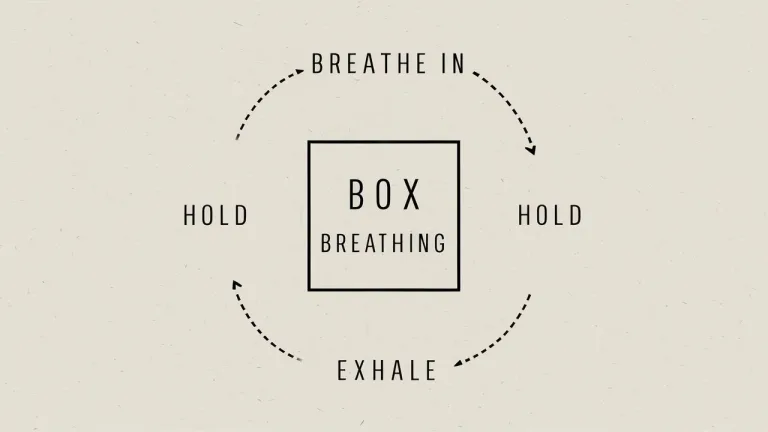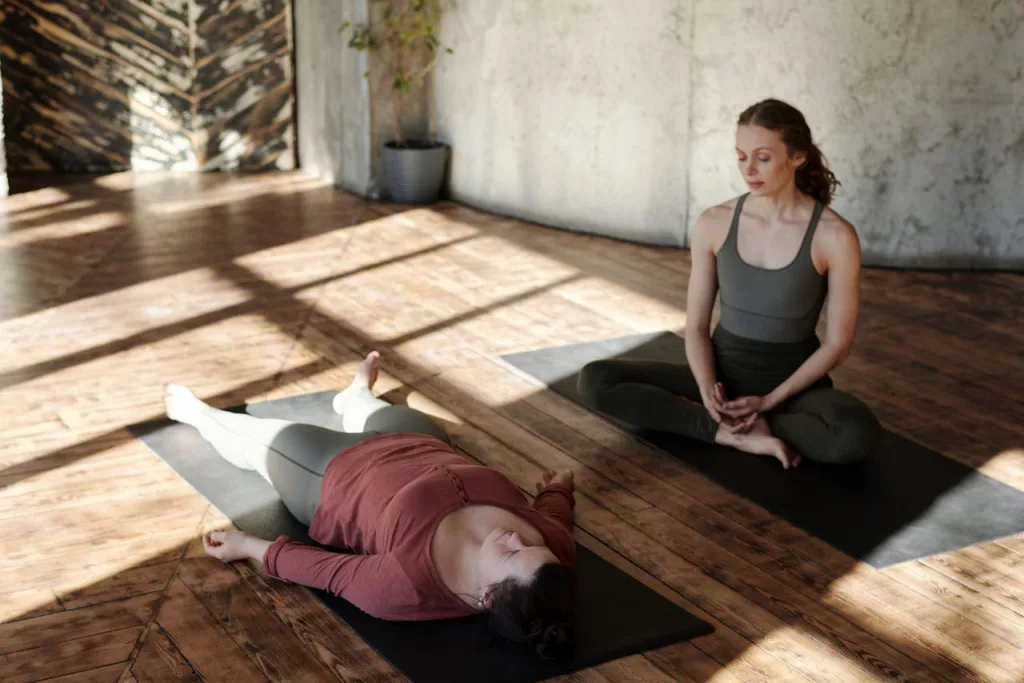Last Updated on 30/10/2025 by Silvija Meilunaite
Lately, everyone has been talking about breathwork. It is popular among spiritual individuals seeking a deeper connection and sports enthusiasts practicing breathwork for workout recovery and endurance.
I am practicing breathwork regularly and have attended multiple breathwork practices in different countries and with different teachers. From very spiritual and deep rebirthing breathwork to holotropic breathwork, which all opened my mind and took me deeper inside.
I had such profound experiences that I am becoming more and more curious about where breathwork can take me, and also want to introduce it to my readers.
Let’s start with basics…..
What is Breathwork?
Breathwork is a practice that uses the breath for healing, personal growth, and spiritual development. It is a deep and active form of meditation focusing on your breath. Changing how we breathe can change how we feel, think, and experience life. Breathwork can help reduce stress, improve focus and concentration, increase energy levels, and release emotions.
Historical Context of Breathwork
Breathwork can be traced back thousands of years to ancient cultures, including Hinduism and Buddhism. These traditions considered the breath a vital life force and developed techniques to utilise its power for health and spiritual enlightenment.
In the 20th century, breathwork saw a comeback and further development in the West by integrating ancient techniques with modern practices.
Types of Breath Work Techniques
1. Pranayama:
It is an ancient yogic practice centered around breath control. Pranayama techniques apply various rhythms of breathing developed to purify, energize, and balance your body and mind, from calming and grounding methods like Ujjayi (Ocean Breath) to energizing and revitalizing practices like Kapalabhati (Skull Shining Breath). Pranayama breathing is practiced fast and slow and has three phrases: Inhale, hold, exhale. Pranayama is practiced alongside yoga. (1)
2. Rebirthing Breathwork:
This technique, created by Leonard Orr in the late 1960s, focuses on releasing suppressed traumatic memories, including birth, through connected and conscious breathing. Breaths are taken in a continuous, rhythmic cycle without pauses between inhalation and exhalation. Traditionally, rebirthing breathwork is practiced lying down, breathing through the mouth. Rebirth breathwork is practiced in one-to-one sessions with a trained practitioner. (2) I have been a part of a rebirthing breathwork practice multiple times and had a profound experience. It helped me heal a very old trauma that I have been carrying all my life. It was mentally hard practice, which brought out many suppressed emotions, but it was definitely life-changing.
3. Holotropic Breathwork:
Developed in the 1970s by Stanislav and Christina Grof, this involves rapid breathing (hyperventilation) supported by music and bodywork to induce altered states of consciousness for therapeutic and spiritual growth. (3) A practitioner ‘SITTER’ supports the session of the ‘BREATHER’, but it is mostly silent. Holotronic is a very deep breathwork that is practiced with eyes closed, lying down. It lasts 1 to 3 hours and ends with mandala drawing and sharing. (4)
It is a very strong practice that can take you on a very beautiful or very beneficial journey, and can help to connect you with your deeper self. I attended a breathwork practice based on holotropic breathwork just yesterday and had an amazing journey that is very hard to explain in words.
4. Box Breathing:
a straightforward technique that anyone can do without any preparation or assistance from others. It is used to reduce stress and improve concentration. It involves breathing in, holding, exhaling, and holding again, all for an equal amount of time. (5) Start with something that is quite easy to do, like 4 seconds, and progress to 6, 8 seconds.
This technique is something that you can practice on your own a few times a day.

5. Wim Hof Method:
This method combines controlled breathing, cold exposure, and meditation to influence the nervous system and immune response. Wim Hof’s breathing technique combines fast breaths with prolonged breath holds (6). Check out one of his breathwork videos below
What is Somatic Breathwork?
Somatic breathwork became a bit of a buzzword that doesn’t really explain the breathwork practice. “Soma” means body, so theoretically, all breathwork is somatic breathwork.
Potential Benefits of Breathwork
1. Physical Benefits
- Improved Respiratory Function: Enhances lung capacity and breathing efficiency, beneficial for overall health and physical endurance.
- Reduced Stress and Anxiety: Lowers cortisol levels, decreasing the physical effects of stress on the body.
- Boosted Immune System: Promotes a healthier immune response.
- Increased Energy Levels: Optimizes oxygen consumption, increasing liveliness.
- Pain Management: Breathwork can help reduce pain perception by releasing endorphins and promoting relaxation.
- Improved sleep: Breathwork can improve sleep quality by helping to achieve relaxation, regulating the nervous system, and reducing stress and anxiety.(7)
2. Mental and Emotional Benefits
- Enhanced Mood: Breathwork can elevate mood by increasing the production of endorphins ( the body’s natural feel-good hormones).
- Improved Focus and Concentration: Deep, rhythmic breathing enhances clarity and attention.
- Emotional Release and Healing: Facilitates the release of repressed emotions and traumas, contributing to emotional balance and well-being.
- Reduced Symptoms of Depression and Anxiety: Regular practice can alleviate symptoms by promoting relaxation and presence.(8)
3. Spiritual Benefits
- Deepened Connection to Self: Breathwork can facilitate a profound inner journey, enhancing self-awareness and self-understanding.
- Enhanced Meditation and Mindfulness Practices: These practices support deeper meditation and mindfulness, promoting inner peace and connectedness.
- Access to Altered States of Consciousness: Some techniques can induce non-ordinary states of consciousness, offering unique spiritual insights and experiences.
- Sense of Oneness and Connectedness: Participants share experiences of unity with the universe or a higher power, fostering a deep understanding of spiritual well-being.
4. Social and Relational Benefits
- Improved Communication Skills: Increased self-awareness and emotional regulation can lead to more effective and compassionate communication.
- Strengthened Relationships: Breathwork can enhance the quality of personal relationships by working through emotional blockages and fostering empathy.
What does the science say about the benefits of Breathwork?
There are some proven benefits, but also some concerns about bias, concluding that more studies are needed :
" While breathwork has become increasingly popular owing to its possible therapeutic potential, there also remains potential for a miscalibration, or mismatch, between hype and evidence. This meta-analysis found significant small-medium effects of breathwork on self-reported/subjective stress, anxiety and depression compared to non-breathwork control conditions. Breathwork could be part of the solution to meeting the need for more accessible approaches, but more research studies with low risk-of-bias designs are now needed." (9)(10)
My personal Breathwork experience
In the last 5 years, I have been to many breathwork practices, as well as practicing it at home. If I am struggling to sleep, a quick breathwork session really helps to calm my nervous system. The best way to do it is a simple 4×8 breathing technique: 4-second inhale, 8-second exhale.
If I feel stressed or overwhelmed, I use 4/7/8 – inhale/hold/
Breathwork can be a very deep practice with very profound spiritual and emotional benefits; you just need to make sure you find a very experienced teacher who can guide you through the journey. But it can also be a short daily practice to keep you present and grounded, and can be a part of your morning or nighttime routine.
I have started my breathwork journey very skeptically, but I had so many beautiful and life-changing experiences that I want to explore it more and more.
If you want to try breathwork but don’t know where to start, here are the BEST BREATHWORK CHANNELS ON YOUTUBE, you can try out.
Conclusion
With holistic practices like breathwork, meditation, and movement therapy, you get what you believe in. If you come to the practice open-mindedly, you will feel the benefits. If you are skeptical and can not let go, the benefits will be less prominent, or it will take you longer to experience them.
Is breathwork hyped and commercialized? Absolutely, but everything in the world is, and that doesn’t mean it doesn’t work. I would encourage you to try a few deep practices with experienced teachers. Go with an open mind and curiosity, and you will experience something life-changing.
Learn about Gratitude practice: Why Gratitude Works: The Benefits and How to Practice It Daily.
If you want to learn about Somatic Yoga, read: WHAT IS SOMATIC YOGA, AND IS IT EVIDENCE-BASED?
To deepen your yoga knowledge, check out The Best Yoga YouTube channels.
If you want to learn a bit more about the importance of nose breathing, read: Mouth Tape for Sleep: Does it Work?
https://www.webmd.com/balance/what-is-pranayama
(5) https://www.webmd.com/balance/what-is-box-breathing
(6)Guided Wim Hof Method Breathing
https://www.wimhofmethod.com/breathing-exercises
https://www.youtube.com/watch?v=tybOi4hjZFQ
(7) https://www.wimhofmethod.com/benefits
(8) How Breath-Control Can Change Your Life: A Systematic Review on Psycho-Physiological Correlates of Slow Breathing
https://www.ncbi.nlm.nih.gov/pmc/articles/PMC6137615/
https://pubmed.ncbi.nlm.nih.gov/36624160/
Silvija Meilunaite, PN1-NC, CSMC, is a certified nutrition and menopause coaching specialist, and a writer in the nutrition and self-improvement field. She explores science-based approaches to holistic health and plant-based nutrition, with a strong focus on researching clean, non-toxic products that support long-term well-being.
- S. Meilunaitehttps://barefootbasil.com/author/silvootegmail-com/
- S. Meilunaitehttps://barefootbasil.com/author/silvootegmail-com/
- S. Meilunaitehttps://barefootbasil.com/author/silvootegmail-com/
- S. Meilunaitehttps://barefootbasil.com/author/silvootegmail-com/





Thank you so much for this amazing article about breathwork, it is a life changer!